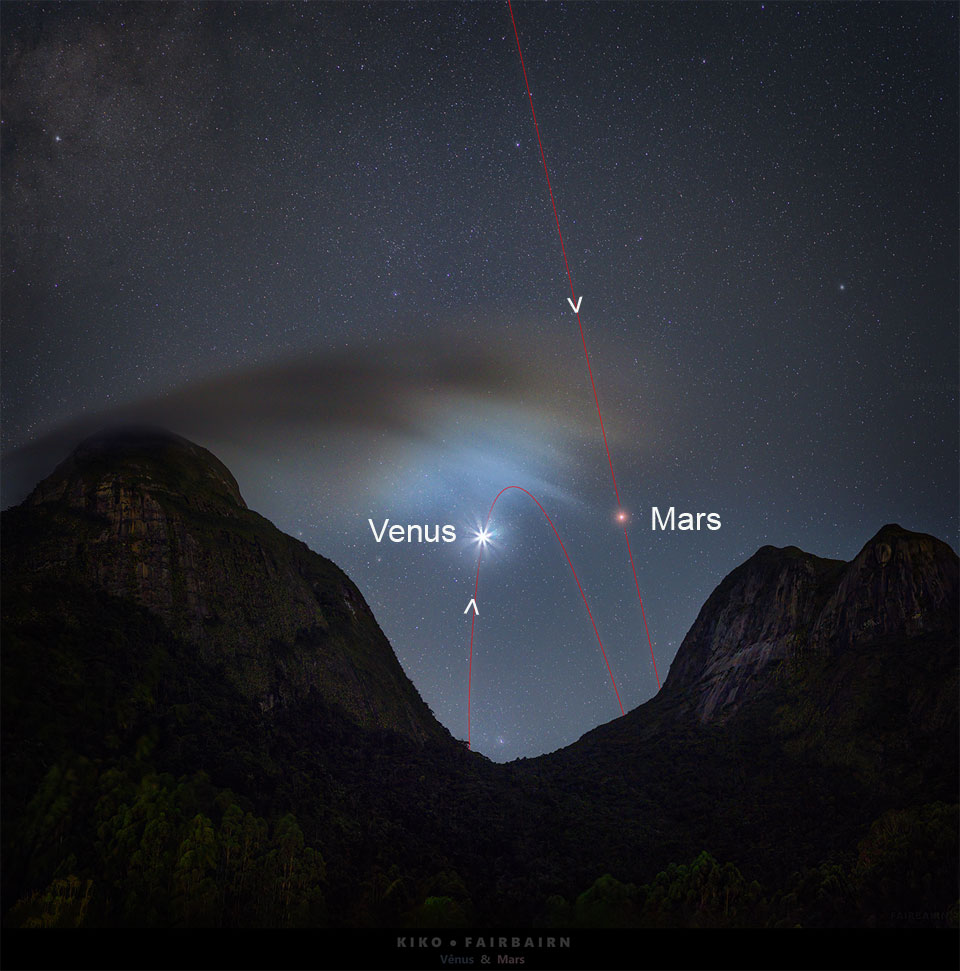29. March 2022
金星 kah 火星:Tī 夜空同齊出現

探索宇宙1!逐工會揀一幅無仝款 ê 影像抑是相片,𤆬你熟似咱這个迷人 ê 宇宙,閣有專業天文學者2為你3解說4。
- 原始文章:Venus and Mars: Passing in the Night
- 影像來源 kah 版權:Carlos Kiko Fairbairn
- 台文翻譯:An-Li Tsai (NCU)
[漢羅] 金星 kah 火星:Tī 夜空同齊出現
這兩粒行星 tī 夜空同齊出現 ê 時陣,in 兩爿攏會看著對方,而且會擋一禮拜以上。 像金星 kah 火星 這個月初 tī 天頂拄著行星 合相 ê 時陣,in 兩个差無夠 4 度闊。 這張相片是幾工前翕 ê,彼當陣 ê 金星 沓沓仔 tī 暗頭仔 peh--起來。 一暝一暝過去,火星 嘛沓沓仔落去矣。 這張相是 kā 4 張鬥做一張 ê,是 tī 巴西 ê 庄頭 Teresópolis 翕 ê。 透早 ê 天頂毋但看會著 金星 kah 火星,這馬 嘛 看會著閣較遠 ê 土星。 這款 合相 只是 in tī 天頂 ê 視角度看起來足倚爾爾。 實際上,金星、火星、土星是 tī 太陽系 內底無仝 ê 所在,in 會繼續 踅太陽行。 後禮拜,土星 kah 火星 ê 視角度會 比 1/4 度閣較細。
[POJ] Kim-chhiⁿ kah Hóe-chhiⁿ: Tī iā-khong tâng-chê chhut-hiān
Chit nn̄g-lia̍p kiâⁿ-chhiⁿ tī iā-khong tâng-chê chhut-hiān ê sî-chūn, in nn̄g-pêng lóng ē khòaⁿ-tio̍h tùi-hong, jî-chhiáⁿ ē tòng chit-lé-pài í-siōng. Chhiūⁿ Kim-chhiⁿ kah Hóe-chhiⁿ chi̍t-ko-goe̍h-chhoe tī thiⁿ-téng tú-tio̍h kiâⁿ-chhiⁿ ha̍p-siòng ê sî-chūn, in nn̄g-ê chha bô-kàu 4 tō͘ khoah. Chit-tiuⁿ siòng-phìⁿ sī kúi-kang-chêng hip ê, hit-tang-chūn ê Kim-chhiⁿ tau̍h-tau̍h-á tī àm-thâu-á peh--khí-lâi. Chi̍t-mî chi̍t-mî kòe-khì, Hóe-chhiⁿ mā tau̍h-tau̍h-á lo̍h-khì ah. Chit-tiuⁿ siòng sī kā 4 tiuⁿ tàu chò chi̍t-tiuⁿ ê, sī tī Pa-se ê chng-thâu Teresópolis hip ê. Thàu-chá ê thiⁿ-téng m̄-nā khòaⁿ-ē-tio̍h Kim-chhiⁿ kah Hóe-chhiⁿ, chit-má mā khòaⁿ-ē-tio̍h koh-khah hn̄g ê Thó͘-chhiⁿ. Chit-khoán ha̍p-siòng chí-sī in tī thiⁿ-téng ê sī-kak-tō͘ khòaⁿ-khí-lâi chiok óa niā-niā. Si̍t-chè-siōng, Kim-chhiⁿ, Hóe-chhiⁿ, Thó͘-chhiⁿ sī tī Thài-iông-hē lāi-té bô-kâng ê só͘-chāi, in ē kè-sio̍k se̍h Thài-iông kiâⁿ. Āu-lé-pài, Thó͘-chhiⁿ kah Hóe-chhiⁿ ê sī-kak-tō͘ ē pí 1/4 tō͘ koh-khah sè.
[KIP] Kim-tshinn kah Hué-tshinn: Tī iā-khong tâng-tsê tshut-hiān
Tsit nn̄g-lia̍p kiânn-tshinn tī iā-khong tâng-tsê tshut-hiān ê sî-tsūn, in nn̄g-pîng lóng ē khuànn-tio̍h tuì-hong, jî-tshiánn ē tòng tsit-lé-pài í-siōng. Tshiūnn Kim-tshinn kah Hué-tshinn tsi̍t-ko-gue̍h-tshue tī thinn-tíng tú-tio̍h kiânn-tshinn ha̍p-siòng ê sî-tsūn, in nn̄g-ê tsha bô-kàu 4 tōo khuah. Tsit-tiunn siòng-phìnn sī kuí-kang-tsîng hip ê, hit-tang-tsūn ê Kim-tshinn ta̍uh-ta̍uh-á tī àm-thâu-á peh--khí-lâi. Tsi̍t-mî tsi̍t-mî kuè-khì, Hué-tshinn mā ta̍uh-ta̍uh-á lo̍h-khì ah. Tsit-tiunn siòng sī kā 4 tiunn tàu tsò tsi̍t-tiunn ê, sī tī Pa-se ê tsng-thâu Teresópolis hip ê. Thàu-tsá ê thinn-tíng m̄-nā khuànn-ē-tio̍h Kim-tshinn kah Hué-tshinn, tsit-má mā khuànn-ē-tio̍h koh-khah hn̄g ê Thóo-tshinn. Tsit-khuán ha̍p-siòng tsí-sī in tī thinn-tíng ê sī-kak-tōo khuànn-khí-lâi tsiok uá niā-niā. Si̍t-tsè-siōng, Kim-tshinn, Hué-tshinn, Thóo-tshinn sī tī Thài-iông-hē lāi-té bô-kâng ê sóo-tsāi, in ē kè-sio̍k se̍h Thài-iông kiânn. Āu-lé-pài, Thóo-tshinn kah Hué-tshinn ê sī-kak-tōo ē pí 1/4 tōo koh-khah sè.
[English] Venus and Mars: Passing in the Night
When two planets pass on the night sky, they can usually be seen near each other for a week or more. In the case of this planetary conjunction, Venus and Mars passed within 4 degrees of each other earlier this month. The featured image was taken a few days prior, when Venus was slowing rising in the pre-dawn sky, night by night, while Mars was slowly setting. The image, a four-part mosaic, was captured in Brazil from the small town Teresópolis. Besides Venus and Mars, the morning sky now also includes the more distant planet Saturn. Of course, these conjunctions are only angular -- Venus, Mars, and Saturn continue to orbit the Sun in very different parts of our Solar System. Next week, the angle between Saturn and Mars will drop to below a quarter of a degree.
詞彙學習
| 漢羅 | POJ | KIP | 華語 | English |
|---|---|---|---|---|
| 金星 | Kim-chhiⁿ | Kim-tshinn | 金星 | Venus |
| 火星 | Hóe-chhiⁿ | Hué-tshinn | 火星 | Mars |
| 土星 | Thó͘-chhiⁿ | Thóo-tshinn | 土星 | Saturn |
| 合相 | ha̍p-siòng | ha̍p-siòng | 合相 | conjunction |
| 行星合相 | kiâⁿ-chhiⁿ ha̍p-siòng | kiânn-tshinn ha̍p-siòng | 行星合相 | planetary conjunction |
| 視角度 | sī-kak-tō͘ | sī-kak-tōo | 視角度 | angule |
| 太陽系 | Thài-iông-hē | Thài-iông-hē | 太陽系 | Solar System |
| 1/4 度 | sì hun chi i̍t tō͘ | sì hun tsi i̍t tōo | 1/4 度 | a quarter of a degree |